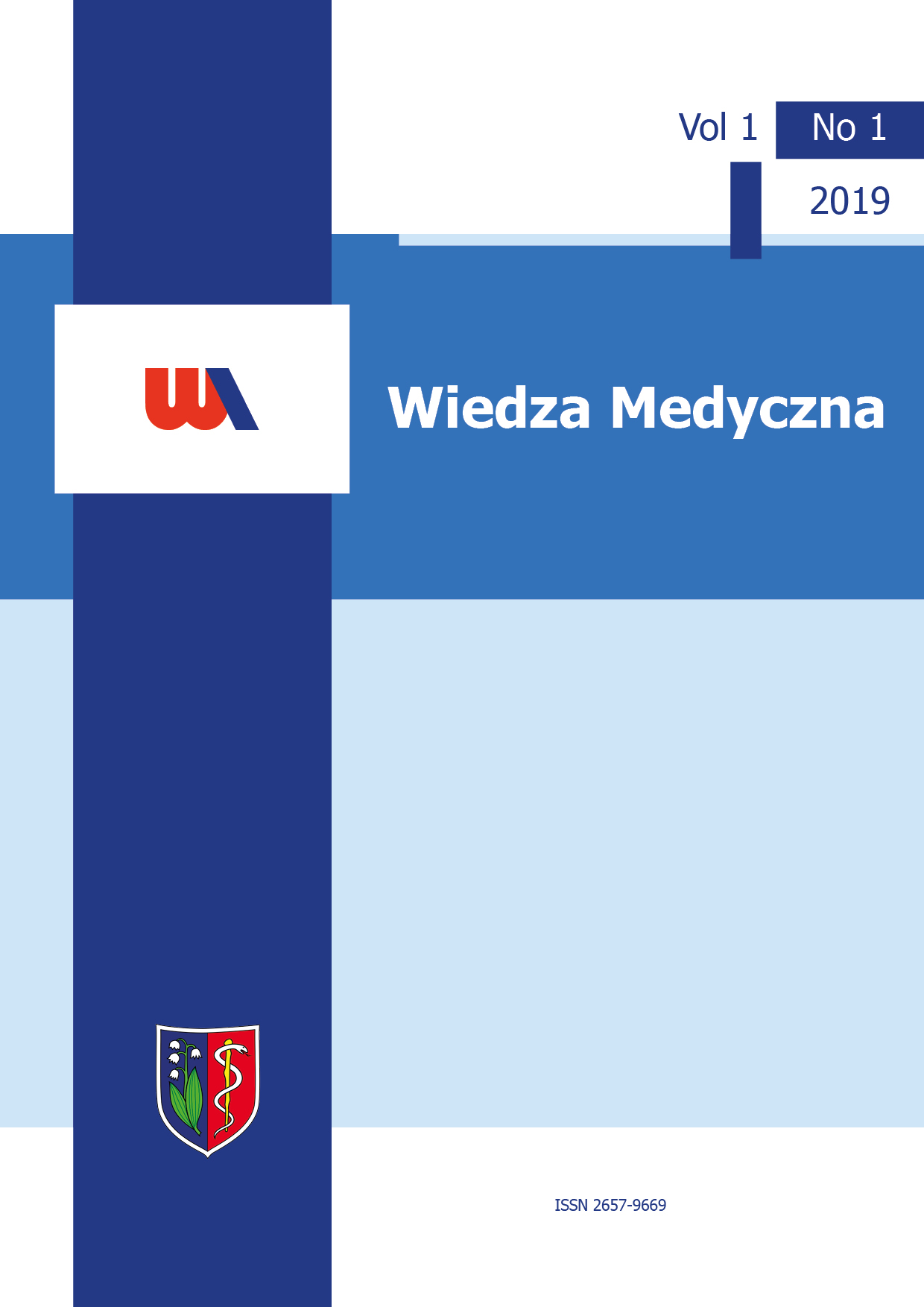Abstrakt
Piodermia zgorzelinowa jest rzadką dermatozą, charakteryzującą się naciekiem neutrofilów w skórze z wtórnym uszkodzeniem ścian naczyń. Dotychczas etiopatogeneza choroby nie została w pełni poznana, podkreśla się jednak rolę czynników immunologicznych. Zmiany skórne najczęsciej lokalizują się na kończynach dolnych, początkowo pod postacią zapalnych guzków lub krost, szerzących się obwodowo z powstaniem owrzodzenia z martwiczym dnem. Oprócz objawów skórnych, obserwuje się także zajęcie innych narządów ‒ płuc, śledziony, nerek, wątroby, trzustki, kości czy narządu uwzroku. Szacuje się, że około 56,8% przypadków piodermii zgorzelinowej współwystępuje z innymi chorobami ‒ w tym najczęsciej nieswoistymi chorobami zapalnymi jelit, reumatoidalnym zapaleniem stawów oraz zaburzeniami hematologicznymi. W leczeniu piodermi zgorzelinowej stosuje się ogólne glikokortykosteroidy, klasyczne leki immunosupresyjne oraz leczenie biologiczne.
Bibliografia
(1) Bolognia J, Schaffer JV, Cerroni L. Dermatology. 4-th ed. Elsevier 2017; 459-463.
(2) Alavi A, French LE, Davis MD, et al. Pyoderma Gangrenosum: An Update on Pathophysiology, Diagnosis and Treatment. Am J Clin Dermatol. 2017 Jun; 18(3):355-372.
(3) Kechichian E, Haber R, Mourad N et al. Pediatric pyoderma gangrenosum: a systematic review and update. Int J Dermatol 2017 May; 56(5):486-495. DOI: 10.1111/ijd.13584. Epub 2017 Feb 23.
(4) Wollina U. Pyoderma gangrenosum ‒ a systemic disease? Clin Dermatol 2015 Sep-Oct; 33(5):527-30. DOI: 10.1016/j.clindermatol.2015.05.003. Epub 2015 May 27.
(5) Marzano AV, Damiani G, Ceccherini I, et al. Autoinflammation in pyoderma gangrenosumand its syndromic form (pyoderma gangrenosum, acne and suppurative hidradenitis). Br J Dermatol 2017; 176:1588-1598.
(6) Marzano AV, Cugno M, Trevisan V, et al. Role of inflammatory cells, cytokines and matrix metalloproteinases in neutrophil-mediated skin diseases. Clin Exp Immunol 2010; 162:100-107.
(7) Marzano AV, Fanoni D, Antiga E, Quaglino P, Caproni M, Crosti C, Meroni PL, Cugno M. Expression of cytokines, chemokines and other effector molecules in two prototypic autoinflammatory skin diseases, pyoderma gangrenosum and Sweet’s syndrome. Clin Exp Immunol 2014; 178:48-56.
(8) Genovese G, Tavecchio S, Berti E, et al. Pyoderma gangrenosum ‒ like ulcerations in granulomatosis with polyangiitis: two cases and literature review. Rheumatol Int 2018 Jun; 38(6):1139-1151.
(9) Ahronowitz I, Harp J, Shinkai K. Etiology and management of pyoderma gangrenosum: a comprehensive review. Am J Clin Dermatol 2012; 13(3):191-211.
(10) Wollina U. Pyoderma gangrenosum ‒ a review. Orphanet J Rare Dis 2007; 2:19.
(11) Ye MJ, Ye JM. Pyoderma Gangrenosum: A Review of Clinical Features and Outcomes of 23 Cases Requiring Inpatient Management. Dermatol Res Pract 2014; 461467.
(12) Binus AM, Qureshi AA, Li VW, et al. Pyoderma gangrenosum: a retrospective review of patient characteristics, comorbidities and therapy in 103 patients. Br J Dermatol. 2011; 165:1244-1250.
(13) Al Ghazal P, Herberger K, Schaller J, et al. Associated factors and comorbidities in patients with pyoderma gangrenosum in Germany: a retrospective multicentric analysis in 259 patients. Orphanet J Rare Dis 2013; 8:136.
(14) Card TR, Langan SM, Chu TP. Extra-gastrointestinal manifestations of inflammatory bowel disease may be less common than previously reported. Dig Dis Sci 2016; 61(9):2619-26.
(15) Gupta AS, Ortega-Loayza AG. Ocular pyoderma gangrenosum: A systematic review. J Am Acad Dermatol 2017 Mar; 76(3):512-518. DOI: 10.1016/j.jaad.2016.08.049.
(16) Yuksel N, Ozdek S. Retinal vasculitis associated with pyoderma gangrenosum: a case report. J Ophthalmic Inflamm Infect 2012; 2:239-241.
(17) Maejima H, Watarai A, Tanabe K, et al. Osteomyelitis in association with pyoderma gangrenosum and ulcerative colitis. Cutis 2014; 93:E14-E1.
(18) Kridin K, Cohen AD, Amber KT. Underlying Systemic Diseases in Pyoderma Gangrenosum: A Systematic Review and Meta-Analysis. Am J Clin Dermatol 2018 Aug; 19(4):479-487. DOI: 10.1007/s40257-018-0356-7.
(19) Wollina U, Tchernev G. Pyoderma gangrenosum: pathogenetic oriented treatment approaches. Wien Med Wochenschr 2014; 164(13-14):263-73.
(20) Soto Vilches F, Vera-Kellet C. Pyoderma gangrenosum: Classic and emerging therapies. Med Clin (Barc) 2017 Sep 20; 149(6):256-260. DOI: 10.1016/j.medcli.2017.04.013.
(21) Sagami S, Ueno Y, Tanaka S, et al. Successful use of adalimumab for treating pyoderma gangrenosum with ulcerative colitis under corticosteroid-tapering conditions. Intern Med 2015; 54(17):2167-72.
(22) Dinarello CA, van der Meer JW. Treating inflammation by blocking interleukin-1 in humans. Semin Immunol 2013; 25(6):469-84.

Utwór dostępny jest na licencji Creative Commons Uznanie autorstwa 4.0 Międzynarodowe.


